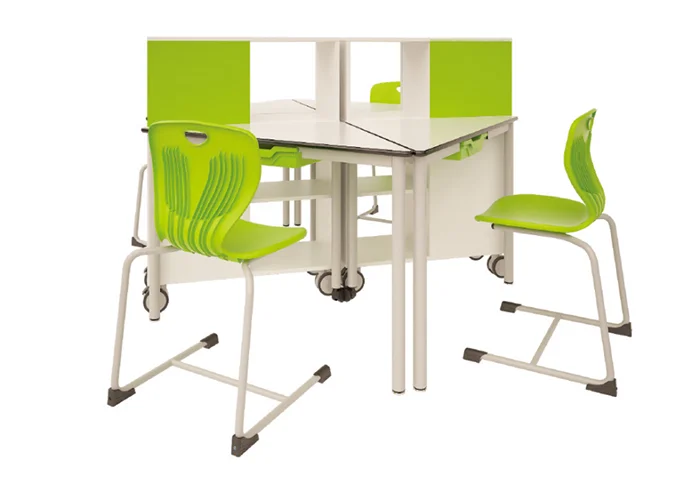Why Collaborative Classroom Desks Are Essential for Modern Education
多行文本内容元素
富文本内容绑定数据后可解析HTML语言内容
Release time:
Jul 24,2025
Summary:Why Collaborative Classroom Desks Are Essential for Modern Education
Table of Contents
Introduction to Collaborative Classroom Desks
Benefits of Collaborative Classroom Desks
Enhanced Learning Experiences
Fostering Communication and Interaction
Developing Teamwork Skills
Design Considerations for Collaborative Desks
Why Collaborative Classroom Desks Are Essential for Modern Education
Table of Contents
- Introduction to Collaborative Classroom Desks
- Benefits of Collaborative Classroom Desks
- Design Considerations for Collaborative Desks
- Implementation Strategies for Schools
- Challenges in Implementing Collaborative Desks
- Case Studies: Successful Implementation
- The Future of Education and Collaborative Learning
- Conclusion
- FAQs About Collaborative Classroom Desks
Introduction to Collaborative Classroom Desks
In today's fast-paced educational landscape, fostering a collaborative environment in classrooms has become crucial. **Collaborative classroom desks** represent a shift from traditional learning models to more interactive and engaging approaches. These desks are designed to facilitate group work, encourage communication, and enhance the overall learning experience. As we delve into the necessity of collaborative desks, it is important to understand their role in modern education and how they contribute to student success.
Benefits of Collaborative Classroom Desks
Incorporating collaborative classroom desks into educational settings offers numerous advantages that extend beyond mere aesthetics.
Enhanced Learning Experiences
One of the most significant benefits of collaborative desks is their ability to promote enhanced learning experiences. When students work together, they engage in **active learning**, which has been shown to improve retention and understanding of the material. Collaborative desks encourage students to discuss ideas, solve problems collectively, and share diverse perspectives, making learning more dynamic and interactive.
Fostering Communication and Interaction
Collaborative classroom desks are designed to break down barriers between students. By arranging desks in groups or clusters, educators create opportunities for students to communicate and interact freely. This interaction not only fosters a sense of community within the classroom but also helps students develop vital communication skills that are essential for their future endeavors.
Developing Teamwork Skills
In an increasingly interconnected world, the ability to work effectively in teams is paramount. Collaborative desks provide a platform for students to learn teamwork skills in a practical setting. Through group projects and collaborative tasks, students learn how to delegate responsibilities, resolve conflicts, and appreciate the strengths of their peers, preparing them for future workplace challenges.
Design Considerations for Collaborative Desks
While the benefits of collaborative desks are clear, their design plays a critical role in their effectiveness.
Flexibility and Adaptability
A well-designed collaborative desk should be flexible and adaptable to various learning activities. Desks that can be easily rearranged allow educators to modify the classroom layout according to specific lesson plans or group sizes. This flexibility supports diverse learning styles, ensuring that all students can engage effectively.
Aesthetic Appeal and Functionality
Aesthetics matter in a learning environment. Collaborative desks should not only be functional but also visually appealing. Bright colors and innovative designs can stimulate student engagement and create a welcoming atmosphere. Educational institutions should consider incorporating desks that align with their branding and overall classroom environment, fostering a sense of pride among students.
Implementation Strategies for Schools
Successfully integrating collaborative desks into a school requires careful planning and execution.
Teacher Training and Support
To maximize the effectiveness of collaborative classroom desks, teachers must be adequately trained. Professional development programs should focus on instructional strategies that leverage collaborative desks. Providing ongoing support and resources can empower educators to feel confident in utilizing these tools to facilitate learning.
Classroom Layout and Configuration
The layout of a classroom significantly impacts the effectiveness of collaborative desks. Schools should consider open spaces that allow for easy movement and interaction among students. Configuring desks in clusters rather than traditional rows encourages teamwork and active participation. Incorporating technology, such as interactive whiteboards or screens, can further enhance collaborative learning opportunities.
Challenges in Implementing Collaborative Desks
While the benefits of collaborative desks are numerous, challenges can arise during their implementation.
Some educators may resist change, preferring traditional teaching methods. Additionally, budget constraints may limit the ability to purchase new desks or modify existing classroom layouts. Addressing these challenges requires open communication, demonstrating the benefits of collaborative learning, and ensuring that educators are equipped with the necessary resources.
Case Studies: Successful Implementation
Several schools have successfully integrated collaborative classroom desks into their learning environments, yielding positive results.
For example, a middle school in California implemented collaborative desks in their science labs, leading to increased student engagement and improved academic performance. Teachers reported that students were more willing to participate in discussions and work together on projects, leading to a richer learning experience. Another high school in New York reported that transitioning to collaborative desks fostered stronger relationships among students, resulting in a more inclusive and supportive classroom atmosphere.
The Future of Education and Collaborative Learning
As education continues to evolve, collaborative learning will play an even more significant role. The increasing emphasis on **21st-century skills**, such as critical thinking and collaboration, aligns perfectly with the principles of collaborative desks. Educational institutions must embrace this shift and recognize that providing students with the tools and environment for collaboration will prepare them for success in an interconnected world.
Conclusion
Collaborative classroom desks are essential for modern education. They enhance learning experiences, foster communication and teamwork, and prepare students for future challenges. By carefully considering design elements and implementing effective strategies, schools can create vibrant learning environments that empower students to thrive. As we continue to advance in educational practices, embracing collaboration will pave the way for a more engaged and successful generation of learners.
FAQs About Collaborative Classroom Desks
1. What are collaborative classroom desks?
Collaborative classroom desks are furniture designed to facilitate group work and interaction among students. They are often arranged in clusters to promote teamwork and communication.
2. How do collaborative desks enhance learning?
Collaborative desks enhance learning by encouraging active participation, fostering communication, and enabling students to work together on projects, which leads to deeper understanding and retention of material.
3. What design features should I look for in collaborative desks?
Look for desks that are flexible, adaptable, visually appealing, and functional. Designs that allow for easy rearrangement and accommodate various group sizes are ideal.
4. What challenges might schools face in implementing collaborative desks?
Challenges may include resistance from educators, budget constraints, and the need for proper training and support for teachers to effectively utilize collaborative desks.
5. How can I measure the effectiveness of collaborative desks in my classroom?
Effectiveness can be measured through student engagement levels, participation in group activities, improvements in academic performance, and feedback from both students and teachers about their learning experiences.


